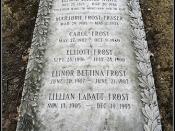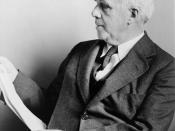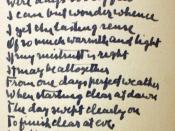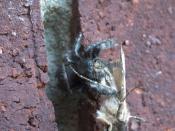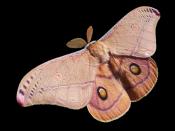Design The title of Robert Frost?s poem "Design? is saturated with meaning. Any reader that delves into Frost?s story will find this to be true. Webster?s Dictionary defines the word design as such: ?to plan out in systematic form, or to create or contrive for a particular purpose or effect? (391). It?s been said that discussions concerning the existence of God are based on the argument for design. The argument being, because the world shows a systematic order, there must be a designer who made it. Frost brings significance to this subject matter by expressing questions in the latter part of his poem. Design, on the other hand, can also mean ?a secret or sinister scheme.? Frost?s poem incorporates and explores each meaning.
Similar to many sonnets, ?Design? is separated into two parts. The first eight lines create an image focusing on the spider. It is ?dimpled and fat? like a baby (1044).
The spider stands on a wildflower whose name, heal-all, is ironic. A heal-all is supposed to cure any disease and is usually violet or blue, but this flower has no power to restore life to the dead moth and is white. Later, in line ten, Frost notes that the heal-all used to be blue. In the second line the spider has hold of a dead moth. The moth is described with an odd simile in line three: ?Like a white piece of rigid satin cloth? (1044). Suddenly, the moth becomes not a creature but a piece of fabric. Satin has connotations of beauty and is used in rich formal clothing such as wedding gowns.
In the fifth line an invisible hand enters. The characters are ?mixed? like ingredients in an evil potion (1044). This hand or force doing the mixing is unknown. One thing quite apparent, though, is the spider?s diabolical feast. It has deliberately woven his web of deception by concealing himself, white on white. The spider knows that the moth, by nature, is attracted to light and will be innocently ?steered? to his death trap (1045). The moth falls victim to the spider as planned. Nature's design is for the spider to deceive and the moth to succumb. ?Steered? carries the suggestion of a steering wheel or rudder that some pilot controls (1045). Like the word ?brought,? it implies that some invisible force charted the paths of spider, heal-all, and moth, so that they arrived together (1045).
The simile in line seven, ?a flower like a froth,? is more ambiguous and harder to describe (1045). A froth is white, foamy, and delicate, like something found on a beach after a wave recedes. However, froth can also be ugly, like the foam on a polluted river. Both the flower?s beauty and repulsiveness are prevalent in this one simile.
In the course of the octave, Frost introduces the ?Assorted characters of death and blight? (1044). These being, ?a dimpled spider, fat and white?, a white flower, and, held up by the flower, ?a moth Like a white piece of rigid satin cloth? (1044). The three are introduced separately to display their irregularity. The last two lines re-describe their unconformity and state, ?A snow-drop spider, a flower like a froth, and dead wings carried like a paper kite? (1045).
In the last six lines of the sonnet, Frost more directly states his theme. He imparts that when things in the universe decrease below a certain magnitude, they pass completely out of the designer?s sight. When creatures are this minute, possibly God doesn?t bother to ?govern? them but rather lets them roam free (1045). Perhaps, the same mindless chance is all that governs human lives.
Frost?s motion becomes extremely apparent in the last two lines. He writes, ?What but design of darkness to appall? - If design govern in a thing so small? (1045). Frost is certainly aware that the word ?appall? means ?to grow pale? in its root sense. His play on words can be bothersome, appalling, or literally make something turn white or pale. Clearly, the color images are the backbone to ?Design? and simply can?t go unnoticed. White is the color of choice, and though it can be interpreted as purity or something pristine, it can also be seen as fear or death or nothingness, therefore, a lack of design. This very considerable word selection for a poem full of white pale images only highlights Frost?s attention to perfection. He leaves the reader with some thought- provoking questions. If a creature so tiny can be deceptive and lethal, what does this imply in relation to humans? Does the design in nature apply to all creatures? Obviously, these implications are rhetorical, which allows the reader to ponder and speculate on the author?s searching inquiry.
